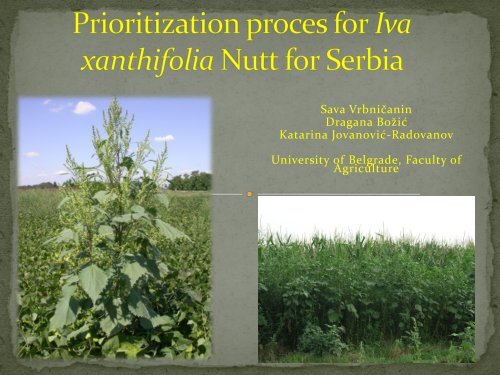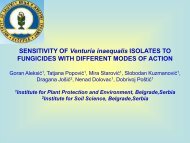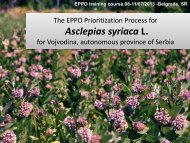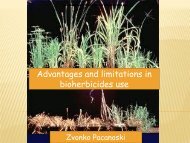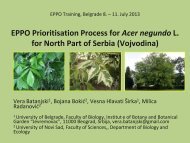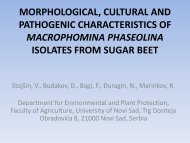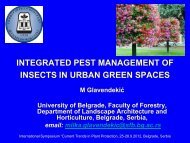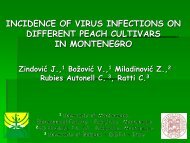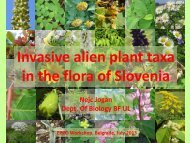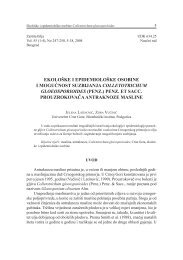Iva xanthifolia - Izbis
Iva xanthifolia - Izbis
Iva xanthifolia - Izbis
- No tags were found...
You also want an ePaper? Increase the reach of your titles
YUMPU automatically turns print PDFs into web optimized ePapers that Google loves.
Sava Vrbničanin<br />
Dragana Božić<br />
Katarina Jovanović-Radovanov<br />
University of Belgrade, Faculty of<br />
Agriculture
Init1 - Enter the name of the pest<br />
<strong>Iva</strong> <strong>xanthifolia</strong> Nutt.<br />
Init2 - Indicate the taxonomic position and synonyms<br />
Cyclachaena <strong>xanthifolia</strong> (Nutt.) Fresen.<br />
Asteraceae (Compositae)<br />
Init3 - Clearly define the PRA area<br />
Serbia
Init4 - Provide the reasons for performing this assessments, and report<br />
any risk analysis available for the assessed species.<br />
It is mostly widespread in warm continental lowlands in eastern part of<br />
Europe:<br />
-southern and eastern Slovakia,<br />
-south-eastern Hungary,<br />
-the easternmost part of Austria and<br />
eastern Germany,<br />
It is also present in Croatia and in north part of Serbia.<br />
Its progressive distribution is influenced by mankind<br />
activities as abiotic changes of environmental conditions,<br />
tourism, stock feast, transport, development and at least is it<br />
effect of graduated climate change.<br />
(Šajinović and Koljadţinski,1966; Horváth et al., 1995; Marković, 2000; Ciocârlan, 2000;<br />
Zhi Dong et al, 2012; Follak et al., 2013)
A.1 - Is the plant species known to be alien in all, or a<br />
significant part, of the area under assessment?<br />
Yes<br />
It is native for south Canada, and therefore<br />
invasive for Serbia (Balkans)
A.2 - Is the plant species established in at least a part of the area<br />
under assessment?<br />
Yes<br />
Ecological conditions of the<br />
Pannonia plane proved to be<br />
very suitable for its fast and<br />
aggressive spreading.<br />
As the result, the area of<br />
distribution of <strong>Iva</strong> <strong>xanthifolia</strong> in<br />
our country expanded. It is<br />
also included in A2 list of<br />
quarantine harmful organisms<br />
and in Serbia it enjoys the<br />
status of invasive species.<br />
(Vrbničanin et al., 2004, Vrbničanin et al,<br />
2009, Konstantinović et al., 2006
Maps of habitat suitability for <strong>Iva</strong> xanthiifolia under current climatic conditions in central and eastern Europe<br />
based on an ensemble modeling approach using four regression techniques (GAM, GBM, GLM, MARS) as<br />
implemented in the BIOMOD-framework. Suitable grid cells are given in grey, unsuitable ones in white.<br />
Projected occurrence probabilities were transformed into presence/
A.5 –<br />
How high is the spread potential of the plant<br />
in the area under assessment?<br />
Medium<br />
Level of uncertainty: low<br />
It is spreading by some crop seed and bird feed as well as by<br />
animals and machinery. It entered Serbia by road and railway<br />
traffic, with dominant way of spreading along roads and<br />
railways.<br />
<strong>Iva</strong> produces seeds extensively, in<br />
average between 35 000 and 50 000,<br />
most up 105 000 seeds, especialy in<br />
the temperate climate with long arid<br />
periods as in here in our country.<br />
(Hanson, 1985; Milanova, 2001; Radovanović et<br />
al., 2012)
A.6 -<br />
How high is the potential negative impact of the plant on native<br />
species, habitats and ecosystems in the area under assessment?<br />
Medium<br />
Level of uncertainty: low<br />
At present <strong>Iva</strong> shows a great aggressivenes and tendency to<br />
spread throughout Vojvodina by taking up a bigger range.<br />
It prefers ruderal areas, with strong anthropogenic influence,<br />
where it establishes monoassociation with influence on<br />
growth and distribution of associated weed species .<br />
Its secondary inhabited habitats are seminatural ecosystems<br />
(increase of population size).<br />
(Inderjit and Keating, 1999; Valkova and Maneva, 2008; Radanovic et al., 2012)
A.7 -<br />
How high is the potential negative impact of the plant<br />
on agriculture, horticulture or forestry in the area under<br />
assessment?<br />
Medium<br />
Level of uncertainty: low<br />
It can be abundant in crops. It has allelopathic<br />
potential on some weeds and crops and can<br />
influence the growth and yield. It has high potential<br />
of consuming soil nutrients (50 plants/m 2 take out<br />
700 kg/ha N, 226 kg/ha P 2 O 5 and 130 kg/ha K 2 O).<br />
(Marisavljević, 2007; Valkova and Maneva, 2008)
A.8 -<br />
How high are the potential additional impacts (e.g. on<br />
animal and human health, on infrastructures, on<br />
recreational activities, other trade related impacts such<br />
as market losses)?<br />
High<br />
Level of uncertainty: low<br />
It may create significant problems for human health<br />
in the medium term (wind-pollinated and causing<br />
different alergic reaction in humans.<br />
(Igić et al., 2005; Follak, 2009; Medvecká et al., 2012; Pyšek et al., 2012;<br />
Follak et al., 2013).
According to the ratings provided, the assessed species falls into the:<br />
Observation list of invasive alien plants
References<br />
•Ciocârlan, V. (2000): Flora Ilustrâta a Românei, Pteridophyta et Spermatophyta, Editura Ceres,<br />
Bucuresti.<br />
•Follak, S. (2009): Vorkommen und potenzielle Verbreitung des Rispenkrauts (<strong>Iva</strong> xanthiifolia Nutt.)<br />
in Österreich. – Bot. Helv., 119: 7–12.<br />
•Follak, S., Dullinger, D., Kleinbauer, I., Moser, D., Essl, F. (2013): Invasion dynamics of three<br />
allergenic invasive Asteraceae (Ambrosia trifida, Artemisia annua, <strong>Iva</strong> xanthiifolia) in central and<br />
eastern Europe. Preslia, 85: 41–61.<br />
•Hanson, C.G., Mason, J.L. (1985): Bird seed aliens in Britain. Walsonia, 15: 237-252.<br />
•Horváth, F., Dobolyi, Z.K., Morschhauser, T., Lokös, L., Karas, L., Szerdahelyi, T. (1995): Flóra<br />
adatbázis 1.2, Taxonlista és attribútum-állomány, MTA Ökológiai és Botanikai Kutatóintézete<br />
Vácrátót.<br />
•Igić, R., Boţa, P., Anačkov, G., Vukov, D. (2005): Atlas alergijskih biljaka Novog Sada, PMF,<br />
Departman za Biologiju i Ekologiju, Novi Sad.<br />
•Inderjit, Keating, K.I. (1999): Allelopathy: Principles, procedures, processes, and promises for<br />
biological control. Adv. Agron., 67:141–231.<br />
•Konstantinović, B., Meseldţija, M., Konstantinović, Bo. (2006): Ambrosia artemisiifolia and <strong>Iva</strong><br />
<strong>xanthifolia</strong> spread and distribution in Vojvodina region. International Plant Protection Symposium<br />
(IV) Debrecin, Hungaria, Proceedings, 281-287.<br />
•Krstić,L.N., Anačkov, G.T., Boţa, P.P., Igić, R.S., Luković, J.Ţ., Vukov, D.M. (2007): Analysis of<br />
anatomical and micromorphological characteristics of <strong>Iva</strong> <strong>xanthifolia</strong> Nutt. Matica Srpska, Novi<br />
Sad, 112: 49-55.
•Marisavljević D. (2007): Biološke karakteristike i suzbijanje ive (<strong>Iva</strong> <strong>xanthifolia</strong> Nutt.) [Biology and<br />
control of False Ragweed (<strong>Iva</strong> <strong>xanthifolia</strong> Nutt.)]. PhD thesis, University of Novi Sad, Faculty of<br />
Agriculture.<br />
•Marković, Lj. (2000): <strong>Iva</strong> L. In: Nikolić, T. (ed.), Flora Croatica, Index Florae Croaticae III, Natura<br />
Croatica, Vol. 9, Suppl. 1, 87.<br />
•Medvecká J., Kliment J., Májeková J., Halada Ľ., Zaliberová M., Gojdičová E., Feráková V.,<br />
Jarolímek I. (2012): Inventory of the alien flora of Slovakia. – Preslia 84: 257–309.<br />
•Milanova, S. (2001): Some morphological and bioecological characteristics of <strong>Iva</strong> <strong>xanthifolia</strong><br />
(Nutt.). Bulgarian Journal of Agricultural Science, 7:141-146<br />
•Pyšek, P., Danihelka, J., Sádlo, J., Chrtek, J. Jr., Chytrý, M., Jarošík, V., Kaplan, Z., Krahulec, F.,<br />
Moravcová, L., Pergl, J., Štajerová, K., Tichý L. (2012): Catalogue of alien plants of the Czech<br />
Republic (2nd edition): checklist update, taxonomic diversity and invasion patterns. – Preslia 84:<br />
155–255.<br />
•Radovanović, M., B.Bokić, B.Radak, M.Rat, J.Šinţar-Sekulić and G.Anačkov (2012): Model for<br />
the secondary spreading area of invasive species <strong>Iva</strong> <strong>xanthifolia</strong> Nutt.1818 (Asteraceae,<br />
Helianthae) from antropogenic dependent on native habitats. International Symposium on Curent<br />
Trends in Plant protection. Belgrade, Proceedings, 89-98<br />
•Šajinović, B., B.Koljadzinski (1966): Nova adventivna vrsta <strong>Iva</strong> <strong>xanthifolia</strong> Nutt. (Cyclachaena<br />
<strong>xanthifolia</strong> Fresen.) u našoj zemlji, Glasnik Prirodnjaåkog muzeja, ser. B, 21: 217-220.<br />
•Štrba, P., Gogoláková, A. (2008): The changes of vertical plant distribution in West Carpathians<br />
Mountains. Comparative Biochemistry and Physiology. Part A, 150: 172.<br />
•Valkova, M., Maneva, S. (2008): Interactions between <strong>Iva</strong> <strong>xanthifolia</strong> Nutt. and other weed<br />
species. Herbologia, 9: 11-21.
•Vrbničanin, S., Karadţić, B., Dajić Stevanović, Z. (2004): Adventivne i invazivne<br />
korovske vrste na području Srbije[Alien and invasive weed species in Serbia]. Acta<br />
biologica Iugoslavica, series G: Acta herbologica, 13: 1-13.<br />
•Vrbničanin S., Malidţa G., Stefanović L., Elezović I., Stanković-Kalezić R.,<br />
Marisavljević D., Radovanov-Jovanović K., Pavlović D. & Gavrić M. (2009):<br />
Distribucija nekih ekonomski stetnih, invazivnih i karantinskih korovskih vrsta na<br />
podrucju Srbije, deo 3: prostorna distribucija i zastupljenost osam korovskih vrsta<br />
[Distribution of some harmful, invasive and quarantine weeds on the territory of<br />
Serbia, Part III: Spatial distribution and frequency of eight weed species]. – Biljni<br />
lekar 37: 21–30.<br />
•ZhiDong, X., GuoHua, D., BaoDong, L. ChunYu, C., Wei, X., XiaoXia, J., ChunYe,<br />
L. (2012): Geographic distribution and prediction of potential suitable regions of <strong>Iva</strong><br />
<strong>xanthifolia</strong>. Acta Prataculturae Sinica, 21: 75-83.


